In this post I’m going to demonstrate why you can’t simply rely upon the rankings information you find online. Widely available rankings do not account for the intricacies of your league. These differences can lead to large swings in the valuations of players.
You should be calculating your own rankings specific to your own league format, especially if you play in a two-catcher league. There is a valuation problem waiting to be exploited in two-catcher leagues.
Please make sure you read to the end. I get a little carried away with examples below, but there are some important conclusions at the end.
This Is Not a Lie
When I run Steamer’s 2014 projections through my ranking system, Buster Posey and Wilin Rosario come out as top 10 players.
Let that sink in. In all the draft preparation and rankings articles you’ve read so far, have you seen any catcher crack the top ten?
You’re a Moron. Your Ranking System Must Be Wrong.
Before you dismiss this out of hand, let’s work through a little exercise. As with most scenarios I outline at this site, let’s assume a 12-team mixed league using standard 5×5 rotisserie categories, 14 hitters (2 C, 1B, 2B, SS, 3B, CI, MI, 5 OF, UTIL), 9 pitchers, and no bench. This would mean 24 catchers would be drafted, 60 OF, and 168 total hitters.
So as not to pick on any one analyst, I’ll be referring to the consensus fantasy baseball hitter rankings that FantasyPros.com puts out (if you don’t use this tool, it’s pretty neat. You can instantly average the rankings of your favorite analysts).
As of March 10th, Buster Posey comes in as the top catcher and 36th ranked hitter. Matt Holliday comes in as the 35th ranked hitter.

Let’s say Team A drafts Holliday and with the very next pick, Team B drafts Posey.
If a ranking system were really accurate, you would think the combined stats from Holliday (the 35th ranked player) and Team A’s final draft pick should be very similar to the combined stats of Posey (the 36th ranked player) and Team B’s final draft pick.
Let’s Take a Look
Because Team A passed on Posey, let’s assume they decide to wait until the last round of the draft to fill their second catcher slot by taking the 24th ranked catcher. In those same consensus rankings, the 24th catcher is Welington Castillo.

And because Team B wasn’t able to take Holliday with their pick, they decide to wait until the last round to draft their fifth outfielder. When the time comes, Team B selects the 60th ranked OF (12 teams * five OF per team). The consensus rankings tell us Kole Calhoun is that guy.

So Team A ends up with Holliday and Castillo. Team B ends up with Posey and Calhoun. Applying Steamer’s 2014 projections to these two teams we get:
| Player |
AB |
H |
AVG |
HR |
R |
RBI |
SB |
| Holliday |
530 |
152 |
.287 |
22 |
78 |
81 |
4 |
| Castillo |
365 |
92 |
.252 |
12 |
41 |
45 |
2 |
| Total Team A |
895 |
244 |
.273 |
34 |
119 |
126 |
6 |
| Player |
AB |
H |
AVG |
HR |
R |
RBI |
SB |
| Posey |
557 |
165 |
.296 |
20 |
78 |
84 |
2 |
| Calhoun |
529 |
141 |
.267 |
17 |
72 |
69 |
11 |
| Total Team B |
1,086 |
306 |
.282 |
37 |
150 |
153 |
13 |
Wow.
Team B wins every category. The reason for this is the concept of the replacement level players. The 60th (last picked) OF is still pretty productive, whereas the last catcher selected is a problem.
Maybe Posey should be ranked higher if he gives you that big of an advantage.
You Cherry Picked This Example. No Way Does This Work Out Like This Every Time.
It is very possible Calhoun is also slanting the results. When I run his Steamer projection through my ranking system he comes out as the 41st OF (so the consensus rankings are underrating him by ranking him the 60th OF). I think he’s a terrific sleeper. So let’s drop twenty three more spots down to Gerardo Parra.
Why Parra, you ask? Well, he does come out as the 60th best OF when I run the 2014 Steamer projections through my ranking calculations. He’s ranked the #83 OF in the FantasyPros consensus ranks.

It would seem that dropping 23 spots further should affect things significantly. But let’s take a look:
| Player |
AB |
H |
AVG |
HR |
R |
RBI |
SB |
| Holliday |
530 |
152 |
.287 |
22 |
78 |
81 |
4 |
| Castillo |
365 |
92 |
.252 |
12 |
41 |
45 |
2 |
| Total Team A |
895 |
244 |
.273 |
34 |
119 |
126 |
6 |
Continue reading “You Need To Read This If You Play In a Two-Catcher League”

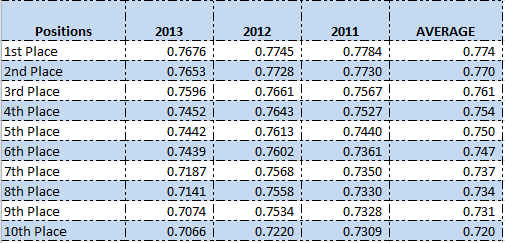


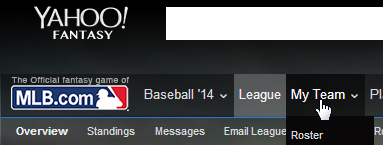

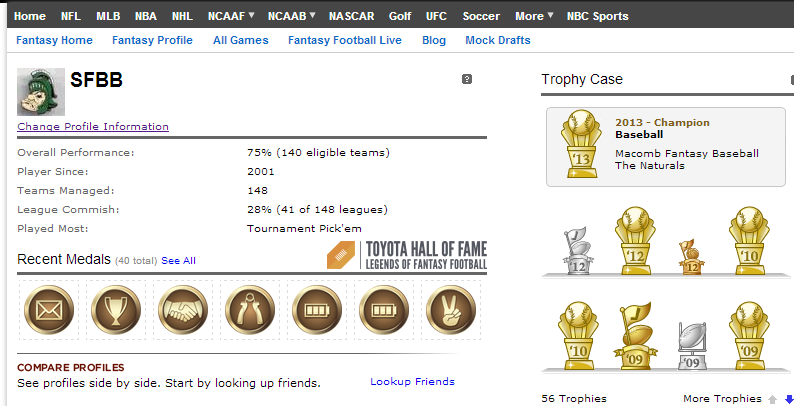

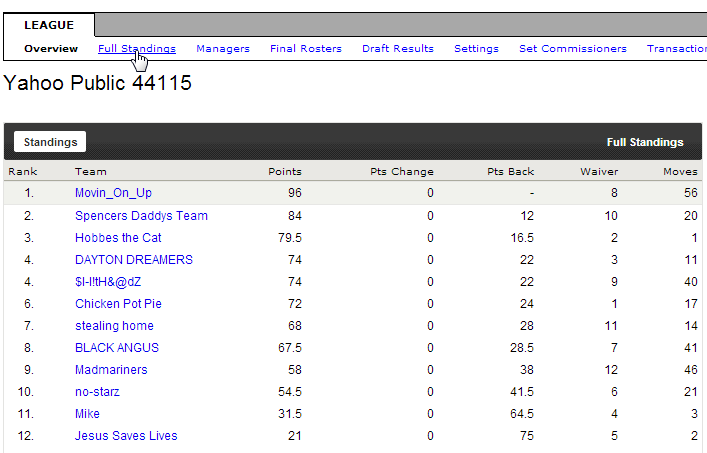
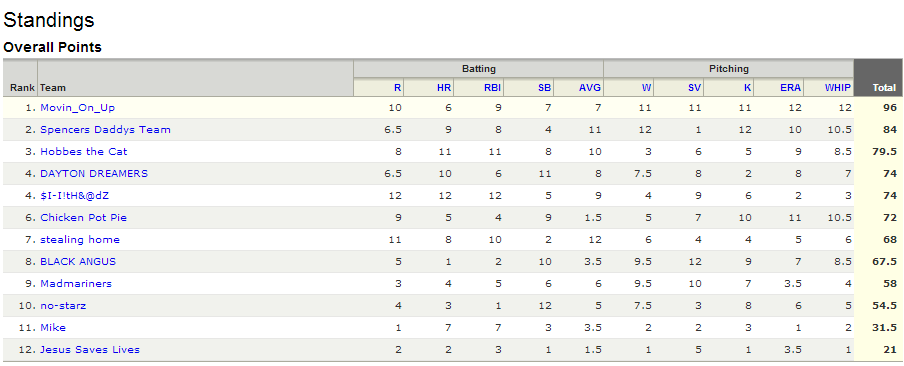 And the accumulated team stat totals are at the bottom.
And the accumulated team stat totals are at the bottom.

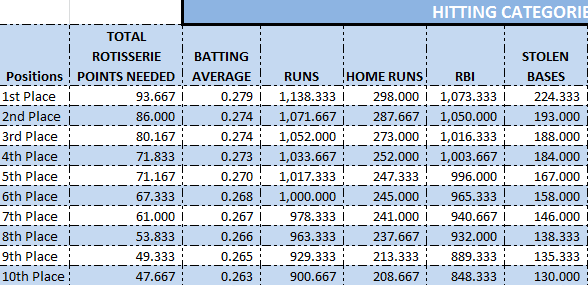
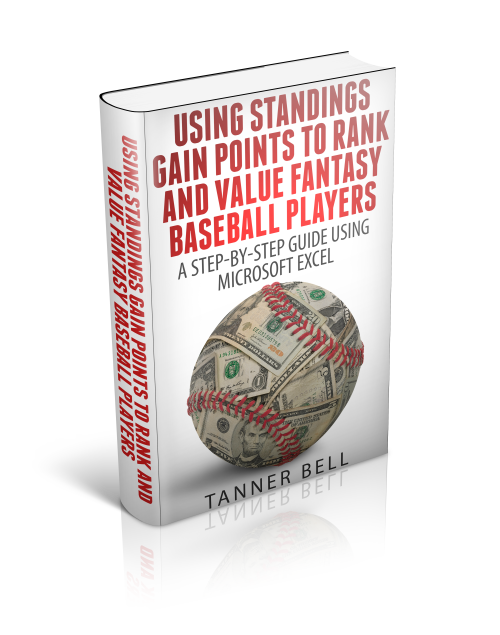 Or use the buttons below if you'd like to purchase the guide now for $9.99.
Or use the buttons below if you'd like to purchase the guide now for $9.99.

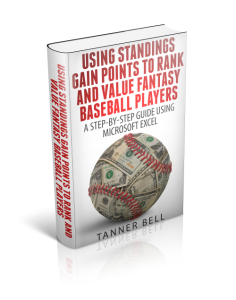 I’m very happy to announce that I’ve just finished the “missing pieces” to the “Create Your Own Fantasy Baseball Rankings” guide.
I’m very happy to announce that I’ve just finished the “missing pieces” to the “Create Your Own Fantasy Baseball Rankings” guide.